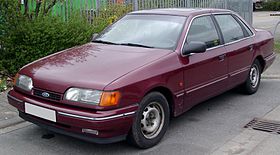Ford Scorpio
| Ford Scorpio | |
|---|---|
 |
|
| Overview | |
| Manufacturer | Ford Europe |
| Production | 1985–1998 |
| Assembly | Cologne, Germany |
| Body and chassis | |
| Class | Executive car (E) |
| Chronology | |
| Predecessor | Ford Granada |
| First generation | |
|---|---|

Ford Scorpio Mk I Saloon
|
|
| Overview | |
| Also called |
Ford Granada Merkur Scorpio |
| Production | 1985–1994 |
| Assembly | Cologne, Germany |
| Designer |
Uwe Bahnsen James Kelly |
| Body and chassis | |
| Body style | 4-door saloon 5-door hatchback 5-door estate |
| Layout | Front-engine, rear-wheel-drive / four wheel drive |
| Platform | Ford DE-1 platform |
| Powertrain | |
| Engine | |
| Transmission | 5-speed Type 9 manual 5-speed MT-75 manual 4-speed A4LD automatic |
| Dimensions | |
| Curb weight | 1,380 kg (3,042 lb) |
| Second generation | |
|---|---|

Ford Scorpio Mk II Saloon
|
|
| Overview | |
| Production | 1994–1998 |
| Body and chassis | |
| Body style | 4-door saloon 5-door estate |
| Layout | Front-engine, rear-wheel-drive |
| Powertrain | |
| Engine |
Petrol: 2.0 L NSD 8V I4 2.0 L N3A 16V I4 2.3 L Y5A/Y5B 16V I4 2.9 L BRG 12V V-6 2.9 L BOB (Cosworth) 24V V-6 Diesel: 2.5 L SCD TD I4 |
| Transmission | 5-speed manual 4-speed automatic |
| Dimensions | |
| Wheelbase | 2,770 mm (109.1 in) |
| Length | 4,825 mm (190.0 in) 4,826 mm (190.0 in) (estate) |
| Width | 1,760 mm (69.3 in) |
| Height | 1,388 mm (54.6 in) 1,442 mm (56.8 in) (estate) |
| Curb weight | 1,577 kg (3,477 lb) |
The Ford Scorpio is an executive car that was produced by Ford Europe from 1985 to 1998. It was the replacement for the European Ford Granada line (although in the UK and Ireland the Scorpio was marketed under the Granada name until 1994). Like its predecessor, the Scorpio was targeted at the executive car market. A variant known as the Merkur Scorpio was sold briefly on the North American market during the late-1980s.
Codenamed DE-1 during its development (since it was intended to straddle the European D and E segments), the Scorpio was heavily based on the Sierra, sitting on a stretched version of its floorpan, and using a similar styling philosophy set by both the Sierra and the third generation Escort. Under the bonnet were well-proven engines, starting with the venerable Pinto engine unit in 1.8 L and 2.0 L capacities, as well as the V6 Cologne engine in 2.4 L, 2.8 L, and later 2.9 L displacements. By the summer of 1989 the Pinto engines had begun to be gradually replaced, with an 8-valve DOHC engine replacing the 2.0 L model.
The Scorpio was intended to maintain Ford's position in Europe as the principal alternative to a Mercedes or BMW for those looking to own an executive car. It was also launched more than a year ahead of new competitors from Rover and Vauxhall. To this end Ford built on the already extensive specification available on the outgoing MkII Granada (which for the period, was very well equipped, with features such as leather heated electrically adjustable seats, air conditioning, electric sunroof and trip computer either standard or available as options) by adding some additional features unusual on a mass-market car. Improvements available included: heated windscreen, cruise control and, later all-wheel drive. The most notable advance was the fitment of anti-lock braking system, the first time this feature had been made standard across the whole range on a mass-produced car. The car was widely praised as being very comfortable and spacious, particularly in respect of its rear legroom.
...
Wikipedia
